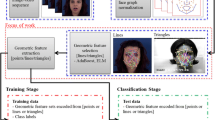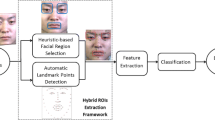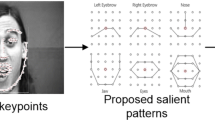Abstract
Measuring the facial expression is an important research and used in many real-time applications. Various methods are proposed in the academia and industry for a decade and still continue to have research potential. This paper proposes a novel scheme by using Interval graph of facial regions. It is assumed that common intersecting salient points of facial regions can be used for estimating the emotions. The facial region is decomposed in four sub regions and the Interval graph is extracted for each region. The common salient points and degree of deformation and direction of deformation are measured for vertical, horizontal and diagonal directions. These values are considered as feature vectors. The well-known datasets such as JAFEE and CK++ are used for evaluating the performance of various classification algorithms and estimating their average classification accuracy. The average classification of the proposed approach is 95.9% and 94.7% for CK++ dataset and JAFEE dataset respectively. The performance of the proposed approach is better when compared to other state of art approaches.












Similar content being viewed by others
References
Bashir Y, Aslam A, Kamran M, Qureshi M I, Jahangir A, Rafiq M, Bibi N, Muhammad N (2017) On forgotten topological indices of some Dendrimers structure. Molecules 24;22(6):867. https://doi.org/10.3390/molecules22060867
Batur AU, Hayes MH (2005) Adaptive active appearance models. IEEE Trans Image Process 14(11):1707–1721
Castrillón M, Déniz O, Hernández D, Lorenzo J (2011) A comparison of face and facial feature detectors based on the viola–jones general object detection framework. Mach Vis Appl 22(3):481–494
Castrillón-Santana M, Hernández-Sosa D, Lorenzo-Navarro J (2012) Combining face and facial feature detectors for face detection performance improvement. In: Alvarez L., Mejail M., Gomez L., Jacobo J. (eds) Progress in pattern recognition, image analysis, computer vision, and applications. Lecture Notes in Computer Science, Springer, Berlin, Heidelberg, 7441:82–89
Chen X, Huang T (2003) Facial expression recognition: a clustering-based approach. Pattern Recogn Lett 24:1295–1302
Chen HT, Liu TL, Fuh CS (2004) Probabilistic tracking with adaptive feature selection. International Conference on Pattern Recognition, Washington DC 2:736–739
Chien SI, Choi I (2000) Face and Facial Landmarks Location Based on Log-Polar Mapping. In: Lee SW, Bülthoff HH, Poggio T. (eds) Biologically Motivated Computer Vision. BMCV 2000. Lecture notes in computer science, vol 1811,Springer, Berlin, Heidelberg, pp 379–386
Cohen I, Sebe N, Cozman F, Cirelo M, Huang T (2003) Learning Bayesian network classifiers for facial expression recognition using both labelled and unlabeled data. In: IEEE Computer Society Conference on Computer Vision and Pattern Recognition, Madison, WI, USA, pp I–I.
Corcoran P, Ionita MC, Bacivarov I (2007) Next generation face tracking technology using AAM techniques. International Symposium on Signals, Systems and Circuits 1:1–4
Cowie R, Douglas-Cowie E, Tsapatsoulis N, Votsis G, Kollias S, Fellenz W, Taylor JG (2001) Emotion recognition in human-computer interaction. IEEE Signal Process Mag 18(1):32–80
Dalal N, Triggs B (2005) Histograms of oriented gradients for human detection. In: computer vision and pattern recognition (CVPR 2005), vol. 1, pp 886–893
Darwin C (1872) The expression of the emotions in man and animals. Murray J, London
Ding Y, Zhao Q, Li B, Yuan X (2017) Facial Expression Recognition From Image Sequence Based on LBP and Taylor Expansion. Special Section On Sequential Data Modeling And Its Emerging Applications, IEEE Access, vol 5
Donahue J, Jia Y, Vinyals O et al (2014) Decaf: a deep convolutional activation feature for generic visual recognition. In: 31st international conference on machine learning. PMLR 32(1):647–655
Ekman P, Friesen WV et al (1978) Facial action coding system: a technique for the measurement of facial movement. Consulting Psychologists Press, Palo Alto
Fasel B, Luettin J (2000) Recognition of asymmetric facial action unit activities and intensities. In: 15th International Conference on Pattern Recognition, Barcelona, Spain, vol. 1, pp 1100–1103
Fasel B, Luettin J (2003) Automatic facial expression analysis: a survey. Pattern Recogn 36(1):259–275
Felzenszwalb PF, Girshick RB, McAllester D, Ramanan D (2010) Object detection with discriminatively trained part-based models. IEEE Transactions on Pattern Analytical and Machine Intelligence 32(9):1627–1645
Freedman D (2004) Active contours for tracking distributions. IEEE Trans Image Process 13(4):518–526
Geetha A, Ramalingam V, Palanivel S (2009) Facial expression recognition- a real time approach. Expert Systems with Applications, Elsevier 36(1):303–308
Happy SL, Routray A (2015) Automatic facial expression recognition using features of salient facial patches. IEEE Trans Affect Comput 6(1):1–12. https://doi.org/10.1109/TAFFC.2014.2386334
HaqMU SA, MahmoodZ SAA (2019) Boosting the face recognition performance of ensemble based LDA for pose. Non-uniform Illuminations, and Low-Resolution ImagesKSII Transactions on Internet and Information Systems 13(6):3144–3166
He C, Mao H, Jin L (2011) Realistic smile expression recognition using biologically inspired features. In: Wang D, Reynolds M (eds) Advances in Artificial Intelligence (AI 2011), Lecture notes in computer science, Springer, Berlin, Heidelberg, vol 7106
Hussain A, Khan MS, Nazir M, Iqbal MA (2012) Survey of various feature extraction and classification techniques for facial expression recognition. In:11th WSEAS international conference on Electronics, Hardware, Wireless and Optical Communications (WSEAS) international conference on Signal Processing, Robotics and Automation, and proceedings of the 4th WSEAS international conference on Nanotechnology, pp 138–142
Jabid T, Kabir MH, Chae O (2010) Robust facial expression recognition based on local directional pattern. ETRI J 32(5):784–794
Kahou SE, Froumenty P, Pal C (2015) Facial expression analysis based on high dimensional binary features. In: Agapito L., Bronstein M., Rother C. (eds) computer vision - ECCV 2014 workshops. ECCV 2014. Lecture Notes in Computer Science, Springer, Cham, vol 8926, pp 135–147
KhanH SM, BibiN SJH, HaiderS A, ZainabS UM, BashirY MN (2019) Localization of radiance transformation for image Dehazing in wavelet domain. Neurocomputing 381:141–151. https://doi.org/10.1016/j.neucom.2019.10.005
Kim YK, Lim JG, Kim MH (2015) Comparison of lip image feature extraction methods for improvement of isolated word recognition rate. Adv. Sci. Lett. 107:57–61. https://doi.org/10.14257/astl.2015.107.14
Ko KE, Sim KB (2010) Emotion recognition in facial image sequences using a combination of AAM with FACS and DBN. In: the 3rd international conference on intelligent robotics and applications (ICIRA’10), springer-Verlag, Berlin, Heidelberg, vol. 1, pp 702–712
Krizhevsky A, Sutskever I, Hinton GE (2012) Imagenet classification with deep convolutional neural networks. In: Pereira F, Burges, C, Bottou L, Weinberger K (eds). Adv Neural Inf Proces Syst 25(2): 1097–1105. https://doi.org/10.1145/3065386
Lee YH, Kim CG, Kim Y, Whangbo TK (2013) Facial landmarks detection using improved active shape model on android platform. Multimed Tools Appl 74(20):8821–8830. https://doi.org/10.1007/s11042-013-1565-y
Lewis TW, Powers DMW (2001) Lip feature extraction using red exclusion. In: selected papers from the pan-Sydney area workshop on visual information processing (VIP ‘00). Sydney, Australia, vol 2:61–67
Liang S, Wu J et al. (2013) Improved detection of landmarks on 3d human face data. In: 35th international conference of the IEEE engineering in medicine and biology society (EMBC), pp 6482–6485
Lienhart R, Maydt J (2002) An extended set of haar-like features for rapid object detection. In: international conference on image processing, vol. 1, pp I–900
Littlewort G, Whitehill J et al. (2011) The computer expression recognition toolbox (cert). In: IEEE international conference on automatic face gesture recognition and workshops (FG 2011), pp 298–305
Lowe DG (1999) Object recognition from local scale-invariant features. In: 7th IEEE international conference on computer vision, vol. 2, pp 1150–1157
Lucey P, Cohn JF et al. (2010) The extended Cohn-Kanade dataset (CK+): a complete dataset for action unit and emotion-specified expression. In: IEEE computer society conference on computer vision and pattern recognition workshops (CVPRW), pp 94–101
Lyons M, Akamatsu S, Kamachi M, Gyoba J (1998) Coding facial expressions with gabor wavelets. In: 3rd IEEE international conference on automatic face gesture recognition, Nara, Japan, pp 200–205
Lyons MJ, Budynek J, Akamatsu S (1999) Automatic classification of single facial images. IEEE transaction on pattern analysis and machine Intelligence 21(12):1357–1362. https://doi.org/10.1109/34.817413.
Ma L, Khorasani K (2004) Facial expression recognition using constructive feed forward neural networks. IEEE Transactions on Systems, Man, and cybernetics 34(3):1588–1595
Mahmood Z, Muhammad N,Bibi N,Ali T (2017) A review on state-of-the-art face recognition approaches. Fractals 25(2) 1750025 (19 pages). https://doi.org/10.1142/S0218348X17500256
Mahmood Z, Bibi N, Usman M. Khan U (2019) Mobile cloud based-framework for sports applications. Multidimensional Systems and Signal Processing;1–29. https://doi.org/10.1007/s11045-019-00639-6
Matthews I, Cootes T, Bangham J, Cox S, Harvey R (2002) Extraction of visual features for lip reading. IEEE Trans Pattern Anal Mach Intell 24(2):198–213
Nguyen HT, Smeulders AWM (2004) Fast occluded object tracking by a robust appearance filter. IEEE Trans Pattern Anal Mach Intell 26(8):1099–1104
Ouellet S (2014) Real-time emotion recognition for gaming using deep convolutional network features. http://arxiv.org/abs/1408.3750.
Pali V, Goswami S, Bhaiya L (2014) An extensive survey on feature extraction techniques for facial image processing. In: 6th international conference on computational intelligence and communication networks, pp 142–148
Pardàs M, Bonafonte A, Landabaso J (2002) Emotion recognition based on MPEG4 facial animation parameters. In: IEEE International Conference on Acoustics, Speech, and Signal Processing, Orlando, FL, pp IV-3624-IV-3627
Pentland A, Moghaddam B, Starner T (1994) View-based and modular eigen spaces for face recognition. In: IEEE conference on computer vision and pattern recognition. Seattle, NA, pp 84–91
Qi C, Li M, et al. (2018) Facial Expressions Recognition Based on Cognition and Mapped Binary Patterns. Special Section On Trends, Perspectives And Prospects Of Machine Learning Applied To Biomedical Systems In Internet Of Medical Things, IEEE Access, vol 6
Shan C, Gong S, McOwan PW (2009) Facial expression recognition based on local binary patterns: a comprehensive study. Image vision Computing 27(6):803–816. https://doi.org/10.1016/j.imavis.2008.08.005
Shen X, Wu WY (2015). An algorithm of lips secondary positioning and feature extraction based on YCBCR color space. In: International Conference on Advances in Mechanical Engineering and Industrial Informatics Atlantis Press. https://doi.org/10.2991/ameii-15.2015.271
Su C, Deng J, Yang Y, Wang G (2010) Expression recognition methods based on feature fusion. In: Yao Y, Sun R, Poggio T, Liu J, Zhong N, Huang J. (eds) Brain informatics (BI 2010). Lecture Notes in Computer Science, Springer, Berlin, Heidelberg, vol 6334, pp 346–356
Susskind JM, Littlewort G, Bartlett MS, Movellan J, Anderson AK (2007) Human and computer recognition of facial expressions of emotion. Neuropsychologia, Elsevier 45(1):152–162
Swaminathan A, Vadivel A, Arock M (2020) FERCE: facial expression recognition for combined emotions using FERCE algorithm. IETE J Res:1–16. https://doi.org/10.1080/03772063.2020.1756471
Tomasi C, Manduchi R (1998) Bilateral filtering for gray and color images. In: IEEE 6th international conference on computer vision. Bombay, India, pp 839–846
Viola P, Jones M (2004) Robust real-time face detection. Int J Comput Vis 57(2):137–154
Wang L, Li RF, Wang K, Chen J (2015) Feature representation for facial expression recognition based on FACS and LBP. Int J Autom Comput 11(5):459–468
Yan S, Shan S, Chen X, Gao W (2008) Locally assembled binary (LAB) feature with feature-centric cascade for fast and accurate face detection. In: IEEE conference on computer vision and pattern recognition (CVPR 2008), pp 1–7
Yang MT, Cheng YJ, Shih YC (2011) Facial expression recognition for learning status analysis. Springer, Berlin Heidelberg, pp 131–138
Yang W, Sun C, Zheng W, Ricanek K (2017) Gender classification using 3D statistical models. Multimed Tools Appl 76(3):4491–4503. https://doi.org/10.1007/s11042-016-3446-7
ZhouF KS, FowlkesC C, ChenT LB (2020) Fine-grained facial expression analysis using dimensional emotion model. Neurocomputing 392(7):38–49
Author information
Authors and Affiliations
Corresponding author
Additional information
Publisher’s note
Springer Nature remains neutral with regard to jurisdictional claims in published maps and institutional affiliations.
Rights and permissions
About this article
Cite this article
Avani, V.S., Shaila, S.G. & Vadivel, A. Interval graph of facial regions with common intersection salient points for identifying and classifying facial expression. Multimed Tools Appl 80, 3367–3390 (2021). https://doi.org/10.1007/s11042-020-09806-5
Received:
Revised:
Accepted:
Published:
Issue Date:
DOI: https://doi.org/10.1007/s11042-020-09806-5




